What is Process Art and why is it important?
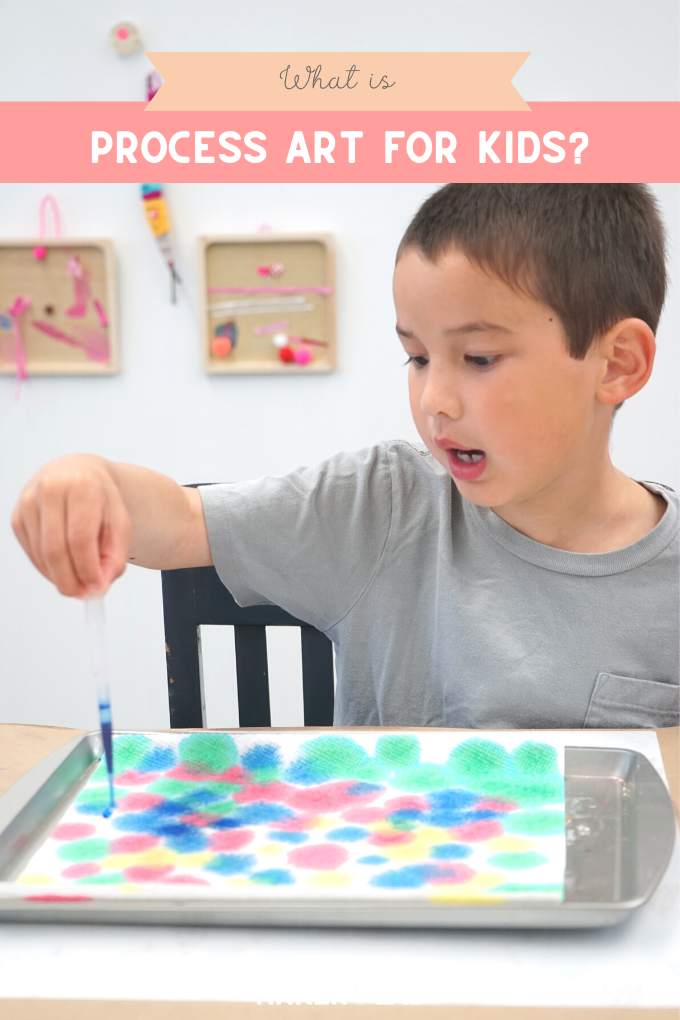
Process Art is art that is child-directed, choice-driven, and celebrates the experience of discovery. In process art, the final product is always unique and the focus lies in the creation of the work, not the outcome.
What we’re going to cover…
How the process art approach benefits adults
Why this is the best approach for preschool art
How to Get Started with Process Art
The differences between process art and product art
What materials are used in process art projects?
What is an example of process art?
Common Pitfalls with Process Art
How do you teach process art in early childhood?
Favorite process art activities for kids
What are the benefits of process art?
There are so many benefits to process art! Process art is developmentally appropriate for toddlers, preschoolers, and young children because it meets them where they are as sensory explorers.
Through process art, children…
- will have more opportunities for creativity, independence, and imagination
- will learn about the physical limitations and possibilities of materials.
- are encouraged to use creative and critical thinking skills.
- will gain confidence to realize their own ideas.
- are motivated to ask questions and experiment.
- will embrace experimentation and mistakes as part of the learning process.
How the process art approach benefits adults
As much as process art is age appropriate and engaging toddlers and preschoolers, parents and early childhood educators generally find that it is easier to facilitate than product-focussed art lessons because it aligns naturally with child development.
Here are a few reasons why:
- Adults facilitate projects and act as co-learners, so they don’t have to hold all the answers. In fact, not knowing the answers can be a huge benefit because it gives adults room to play and experiment themselves.
- Process-focussed projects don’t require a lot of fancy set up or unique materials that are hard to come by. This saves both time and money.
- Because the goal of process art is to explore and discover, rather than achieve perfection, adults are also emotionally free to support whatever the child dreams up as an ideal solution or end result. No fighting, tears, or half-completed projects.
Why this is the best approach for preschool art
After reading up on all these amazing benefits are you still wondering if process art is the best way to teach art to toddlers, preschoolers, and kids?
There are plenty of good reasons to introduce kids to crafts projects, namely connecting to history and culture, developing hand-eye coordination, learning skills like paper folding, and bonding with family members or friends over craft traditions.
Crafts have their place and I happen to love them, even for kids. But when it comes down to helping children think like artists and inventors, process art, rich with open ended explorations that follow the child’s interests, is always the way to go.
How to Get Started with Process Art
- Offer self-serve supplies that the child can easily use independently
- Allow children to come and go as they please
- Provide interesting art materials
- Allow the child to follow his or her interests
- Keep the focus on open-ended activities that don’t have just one outcome
- Be playful and joyful in the art-making process
- Ask open-ended questions and make objective comments about the child’s artwork
The differences between process art and product art
Sometimes I’ll hear people talk about process art versus product art as if they’re opposing ideas. In some sense they are, and I’ll explain what that’s about in a moment. First, however, I’d like to dispel a myth that process and product can’t work together, when in fact they can!
When people pit process against product, they’re generally referring to how children make art. Process art’s goals relate to what happens during the art sessions, while product art’s goals relate to the final outcome.
Something I’d like you to keep in mind with all of this is that we shouldn’t think about process and product as polar opposites because product is almost always embedded in process. When a child goes through the process of making a work of art, it’s likely that he or she has an idea, question, curiosity, or even product in his or her mind. It may not be evident to us as viewers, but there’s always an intention behind the process, and sometimes that intention connects to a final product.
This isn’t really what people are getting at, however, when they talk about process versus product. The debate is actually about the intention behind the art experience itself. Let’s take a look at the breakdown in terms of how a process project and a product project might look…
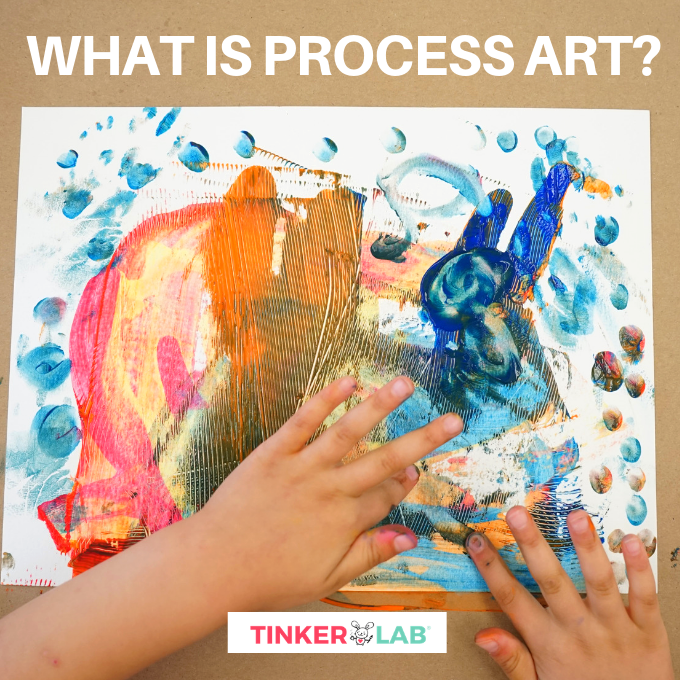
Process Art…
- is child-directed
- celebrates the experience of discovery
- has unique outcomes with no two pieces looking alike
- is open-ended with multiple avenues for discovery
Product Art…
- is adult driven
- offers the child clear steps that have to be followed
- expects the final product to look like a sample
- what you might think of as crafts projects
- has expectations around a right and wrong way to do it

What materials are used in process art projects?
Any and all materials can be used in process art. It’s less about what is used and more about how it’s used, but I do have a tip for assembling a successful process art prompt. Gather supplies that fall into four different categories and you’ll have something fabulous to play with: base, connector, tool, and treasure
The base: paper, clay, cardboard, or wood, cardboard rolls,
Connectors: glue, yarn, tape, slip (mushy wet clay)
Tools: a pencil, paint brush and paint, fork, sponges, crayon, skewer, markers, scissors
Treasures: foil, tissue paper, bubble wrap, beads, sequins
Example #1: clay, slip, skewer, bubble wrap
Example #2: cardboard, hot glue gun, tempera paint sticks, foil
9 Process Art Projects from TinkerLab
What is an example of process art?
Maybe it would help to see this type of open ended making actually looks like with toddlers, preschoolers, and kids? Let’s take a look to see what ideas children have when given the opportunity to create with materials, with no product oriented expectation in mind.
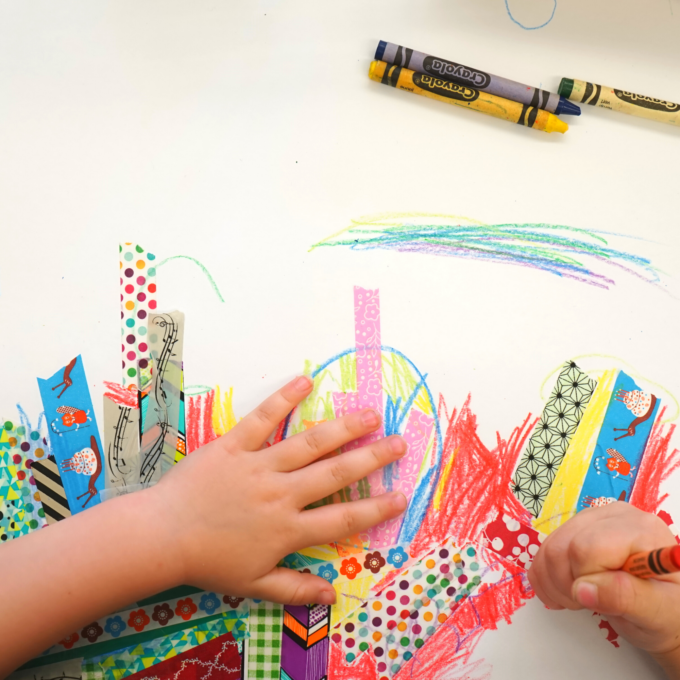
Large sheet of paper (base) + washi tape (connector and treasure) + crayons (tool)
This started as an invitation to create with a bundle of three crayons, connected together with a loop of washi tape. The child had no interest in drawing with a crayon bundle, deconstructed it by removing the tape, asked for more tape, and made this energetic composition with crayon and tape. Marvelous!
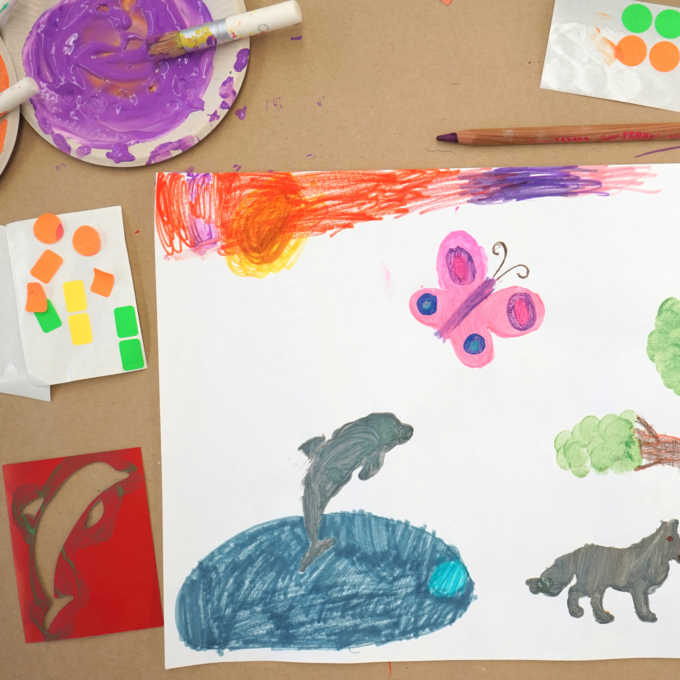
Paper (base) + stencil (tool)+ office stickers (connector and treasure)+ markers (tool)+ paint brushes with paint (tool) colored pencils (tool)
Although this is a semi-realistic illustration inspired by the stencil, the child was not guided to do anything specific and this is the direction they chose to take this in.
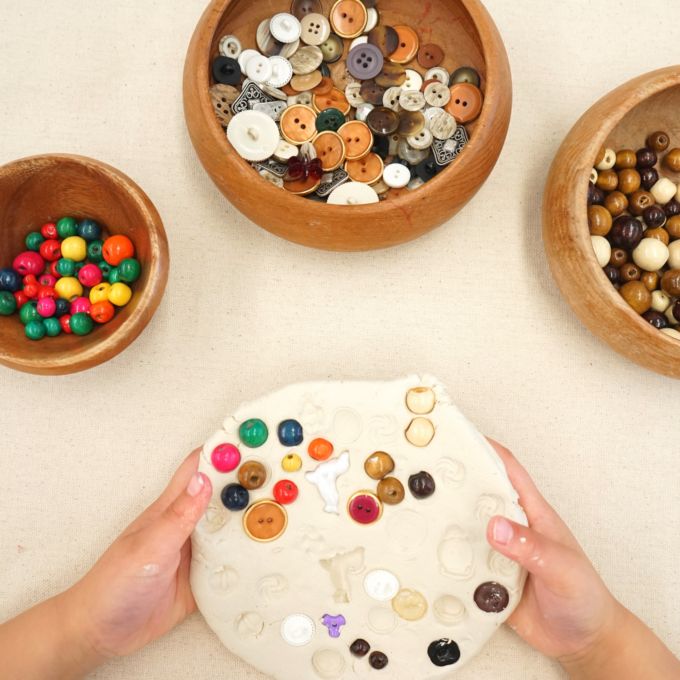
Clay (base and connector) + Beads and Buttons (treasure and tool)
Notice how the beads double as a treasure and mark-making tool. The child decided to pull all the beads and buttons out when they were done, returning the clay to its original state. There was literally no product with this creation, as it all got returned to the art shelf when they were done.
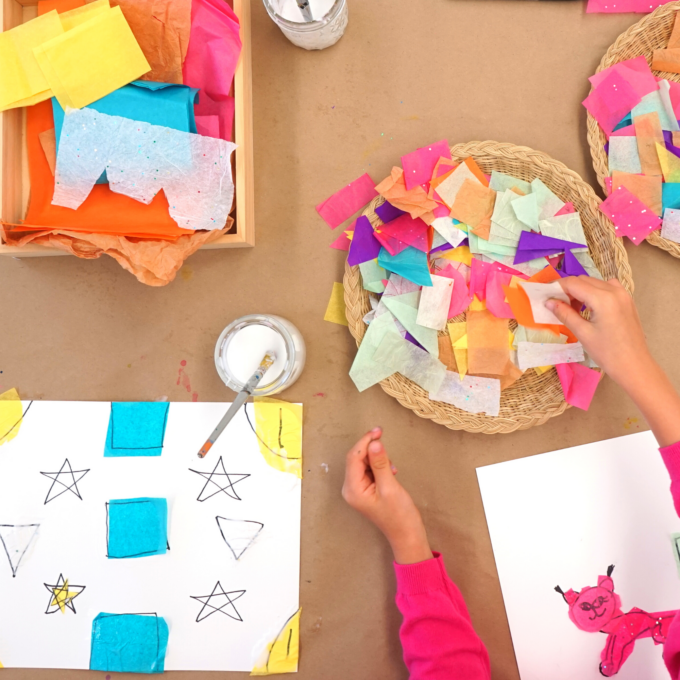
Heavy paper (base) + White glue and paint brush (connector) + Tissue paper (treasure), Marker (tool – off camera)
In this example, notice how two children used the same materials to create two entirely different outcomes. On the left, an organized design with symmetrical balance. On the right, a whimsical animal is taking shape.
If you’re digging this topic, I wrote this fun piece for Americans for the Arts that I think you’ll enjoy: Process over Product: Building Creative Thinkers Through Art.
Common Pitfalls with Process Art
There’s not much you can do wrong with this kind of art making because children lead the way once the materials are laid out. However, getting to that place where we simply step back can be hard for a lot of people. Here are three things that can block a good process art experience:
- Don’t stop your child to tell them what you think they should do. Instead, just pause, take a deep breath, and give your child room to keep making. You can ask them to tell you more about what they’re doing. Usually this little bit of information helps us see their intention, reminding us they’re on the right track.
- Don’t doubt the process. Maybe you thought your child would use the materials one way, but they’re doing something else, and you think: “This is not working. They’re not learning anything. What’s the point of all of this?” This is a totally normal reaction to process art. Instead, trust the process. If you’re not sure where it’s all leading, ask your child to tell you more about their ideas. I promise you’ll be amazed at what they have to share.
- Take off your perfection hat. Cookie cutter projects are now a thing of the past. Paper may be cut at a crooked angle, white spaces may show through quick paint strokes, and lines might be draw so faint that you can barely see them. What you see in your child’s work may not live up to your expectations, and instead please just change your expectations. Notice the beauty of the wobbly lines, the personality of the paint strokes, and the energy behind the novice cut lines. Tell yourself how beautiful and charming it all is, and look for evidence of your child’s imagination, ideas, and curiosities.
How do you teach process art in early childhood?
Use the tips offered in this post and you’ll be well on your way to leading meaningful process art experiences! If you could use a little more assistance, helping families and teachers find easy ways to bring process art to life is my jam and I’d love to welcome you into our tight knit community as a member of our subscription program, TinkerLab Schoolhouse, where we go deeper into process art and you’ll gain access to a library of hundreds of playful prompts.
Favorite process art activities for kids
Now that you know more about process art, let’s dive into some process art projects that you can try today:
Watercolor Paint on Doilies: Process Art with a Beautiful Outcome – ages 3 and up
Collage with Leaves, Glue, and Cardboard – ages 3 and up
Sticking Tape to Paper Bags – ages 2 and up
Office Stickers inside a Drawn Frame – ages 2 and up


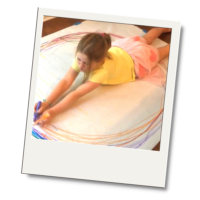
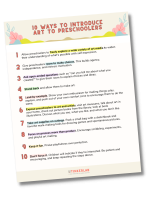
Thank you for this very clear and concise description of process art..I am working on a project in Istanbul Turkey which I hope will encourage Turkish parents to experiment more with process vs product art with their young children (aged 3 and under) and will be happy to refer curious parents to this post!
This is a beautiful explanation of process art. I am beginning hosting classes for toddlers and preschoolers, one of which is a process art class. Would you mind if I use some of your words as part of my class description piece?
[…] Art on Paper is a process art activity that will lead to surprising discoveries and build creative confidence in […]
[…] and I’ve been making found object art pieces like these since I was a kid. This engaging process art activity appeals to makers of all ages, making it a great building project for families, multi-age […]
[…] Valentine’s Day crafting with your preschooler, one of my best bits of advice is to set up an open-ended process art experience that allows your child to make choices and feel […]
[…] This project, like so many others that you’ll find on TinkerLab, is a process art activity. […]
[…] process art activity is easy to set up and a developmentally appropriate art experience for toddlers and preschoolers. […]
[…] painting is such a fun painting process art project with completely unexpected outcomes. I did this with my preschool child and our experience follows. […]
[…] https://tinkerlab.com/what-is-process-art-for-kids/ […]
[…] it comes to kids’ art, people already get this. It’s called process art. It’s about the process of making art rather than the product itself. Process art says […]
[…] like how Rachel of Tinkerlab summarized process art. “Process Art is art that is child-directed, choice-driven, and […]
[…] belief system when it comes to art is that kids reap the most out of process art. That means that they are not doing a specific craft but rather exploring a set of materials or a […]
[…] doing art with toddlers, process art is best! This is art where the end result isn’t important, the focus is on the process. When […]
[…] pursuing my degree in Education, I quickly learned the importance of process-focused artwork and it forever changed how I view children’s art activities. Process-focused art is completely […]
[…] schools. I’ve talked about it before, so I won’t get into it in detail here. But it’s called process art. The basic premise is that the act of being creative is more important than the product of that […]
[…] To read more about process and product art, you can check out Tinker Lab’s blog! […]
[…] that you give kids a finished product and ask them to make something that looks like that, and art that is the child’s choosing. They are able to create and develop their own sense of style and […]
[…] https://www.naeyc.org/resources/pubs/tyc/feb2014/process-art-experienceshttps://tinkerlab.com/what-is-process-art-for-kids/ […]
[…] To learn more about process art and all it’s benefits, check out this article by Tinker Lab! […]
[…] is process art? My friend Rachelle at Tinkerlab (an awesome art teacher!) shares that “Process Art is art that is child-directed, […]
[…] course of artwork? My good friend Rachelle at Tinkerlab (an superior artwork instructor!) shares that “Course of Artwork is artwork that’s […]
[…] is process art? My friend Rachelle at Tinkerlab (an awesome art teacher!) shares that “Process Art is art that is child-directed, choice-driven, […]
[…] is course of artwork? My pal Rachelle at Tinkerlab (an superior artwork trainer!) shares that “Process Art is art that is child-directed, […]
[…] process leaf art activity for kids is easy to set up and a developmentally appropriate art experience for toddlers and […]